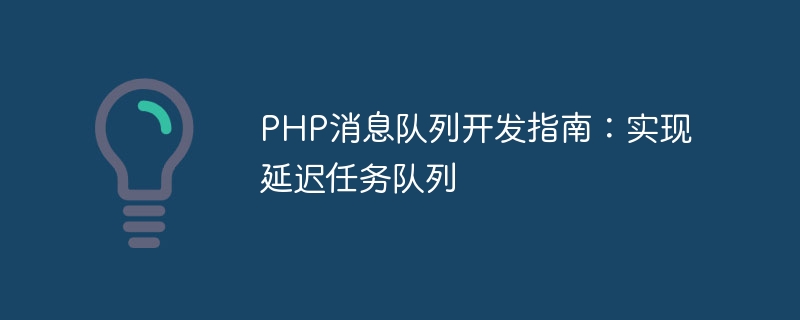

PHP Message Queue Development Guide: Implementing Delayed Task Queue
In the context of the continuous popularity of Internet applications today, high concurrency and high availability are faced by every developer challenges. In order to solve this problem, message queue has become a very important solution, which can help developers achieve system decoupling, improve performance, and implement asynchronous processing and other functions. This article will introduce how to use PHP to develop message queues, especially how to implement delayed task queues.
1. What is a message queue?
Message queue is a commonly used method for asynchronous communication between distributed systems. Its basic principle is to write messages into the queue, and then the consumer reads and processes them from the queue. The message queue has the following advantages:
2. Message queue framework in PHP
In PHP, there are many message queue frameworks to choose from. The most commonly used ones are Redis and RabbitMQ.
3. Methods to implement delayed task queue
Delayed task queue is a special message queue used to implement delayed execution of scheduled tasks. Two common implementation methods are introduced below.
4. Sample code
Take Redis as an example to demonstrate how to implement a delayed task queue:
<?php
$redis = new Redis();
$redis->connect('127.0.0.1', 6379);
// 生产者将消息写入队列
function produceJob($job, $delay) {
global $redis;
$data = [
'job' => $job,
'delay' => $delay,
'timestamp' => time()
];
$json = json_encode($data);
$redis->zadd('delay_queue', time() + $delay, $json);
}
// 消费者从队列中读取延迟任务并处理
function consumeJob() {
global $redis;
$json = $redis->zrangebyscore('delay_queue', 0, time(), ['limit' => [0, 1]]);
if (empty($json)) {
return;
}
$redis->zrem('delay_queue', $json[0]);
$data = json_decode($json[0], true);
$job = $data['job'];
// 处理延迟任务
echo "处理延迟任务:$job
";
}
// 测试
produceJob('任务A', 10);
produceJob('任务B', 20);
produceJob('任务C', 30);
while (true) {
consumeJob();
sleep(1);
}
?>Through the above code, we can see how to use Redis to implement Simple deferred task queue. The produceJob function is used by producers to write messages to the queue, and the consumeJob function is used by consumers to read and process messages from the queue.
Summary:
This article introduces the basic principles of message queues and common PHP message queue frameworks, as well as how to use Redis to implement delayed task queues. Message queue is one of the commonly used solutions in modern applications, which can help us improve the performance and scalability of the system. I hope that readers can have a deeper understanding of message queues through this article and be able to use them flexibly in actual development.
The above is the detailed content of PHP Message Queue Development Guide: Implementing a Delayed Task Queue. For more information, please follow other related articles on the PHP Chinese website!